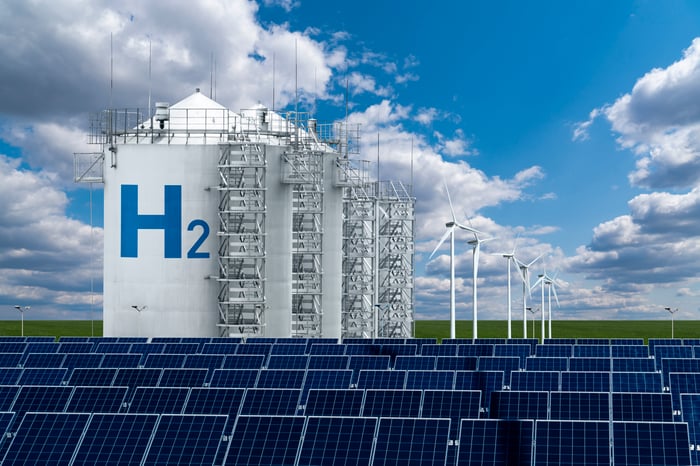In an uncertain economy, there are a few things that we do know. One is that three large pieces of legislation have already been passed that will boost spending on domestic infrastructure going forward: The Bipartisan Infrastructure Act, the CHIPS Act for semiconductor manufacturing, and the Inflation Reduction Act, which is full of green energy incentives.
We also know that those funds are just beginning to be spent. So, no matter what happens with consumer spending, it does appear that this stimulus will go to benefit certain companies developing next-gen infrastructure, especially in clean energy and manufacturing.
Last week, the White House announced where more than $7 billion of those funds would go, awarding $7 billion for hydrogen hub projects across seven different regions of the U.S.
For those who aren't aware, here's why hydrogen could be a key energy source for the rest of this decade, and also which companies should benefit from this legislation.

Image source: Getty Images.
Why hydrogen?
Hydrogen has the potential to be a key tool in the fight against climate change, as it's a completely emission-free fuel. Hydrogen importantly also has the potential to de-carbonize various industries that are hard to power by renewable fuel alone. These include heavy-duty trucking, along with heavy industry such as steel, glass, and cement production. In addition, hydrogen can act as an important "baseload" fuel, as it can be stored in the same manner as fossil fuels. Some call it the "Swiss army knife" of clean energy.
However, the drawback is that hydrogen also takes a lot of energy to produce, and as of this moment, is usually more expensive than fossil fuels, depending on how it's made. And unfortunately, the cost of "green hydrogen" -- or hydrogen produced through electrolysis from renewable sources -- is higher than "grey" hydrogen made from natural gas or other fossil fuels. "Blue" hydrogen is made from natural gas with carbon capture, but carbon capture also raises costs.
Still, with the help of the government spurring along industry investment, the prevailing goal is that green or blue hydrogen costs will fall 80% before the end of the decade to $1 per kilogram, which would further spur wider use of this zero-emission fuel. This would be similar to the cost reduction renewables saw after the 2009 green stimulus package following the 2008 financial crisis.
7 hubs of hydrogen
On Oct. 13, the Biden administration announced the winners of seven U.S. hydrogen hub projects, which the White House expects will catalyze another $40 billion in private investment for the new hydrogen economy. The release went on:
Collectively, the hubs aim to produce more than three million metric tons of clean hydrogen per year, thereby achieving nearly one third of the 2030 U.S. clean hydrogen production goal. Together, the seven Hydrogen Hubs will eliminate 25 million metric tons of carbon dioxide emissions from end uses each year -- an amount roughly equivalent to combined annual emissions of over 5.5 million gasoline-powered cars. The nearly $50 billion investment is one of the largest investments in clean manufacturing and jobs in history.
The seven projects are as follows, with the following companies named as partners:
|
Project |
States |
Amount Awarded |
Partner companies |
Hydrogen Production Method |
|---|---|---|---|---|
|
Mid-Atlantic |
Pennsylvania, Delaware, New Jersey |
$750 million |
Air Liquide (AIQUY -1.51%), DuPont (DD -2.35%), Enbridge (ENB -1.23%), PBF Energy (PBF 3.44%), others |
Renewables, nuclear |
|
Appalachian |
West Virginia, Ohio, Pennsylvania |
$925 million |
Natural gas w/ carbon capture |
|
|
California |
California |
$1.2 billion |
Chevron (CVX 1.89%), Microsoft (MSFT -1.32%), Brookfield Renewable (BEPC) |
Renewables, biomass |
|
Gulf Coast |
Texas |
$1.2 billion |
Exxon (XOM -0.36%), Chevron, Air Liquide, Sempra (SRE -4.94%) |
Natural gas w/ carbon capture, renewables |
|
Heartland |
Minnesota, North Dakota, South Dakota |
$925 million |
Xcel Energy (XEL -4.55%), Marathon Petroleum (MPC -0.04%), TC Energy (TRP -2.28%) |
Nuclear, renewables, natural gas |
|
Midwest |
Illinois, Indiana, Michigan |
$1 billion |
Air Liquide, BP (BP 0.55%), others |
Renewables, natural gas, nuclear |
|
Pacific Northwest |
Washington, Oregon, Montana |
$1 billion |
Renewables |
Data sources: whitehouse.gov, Reuters, Yahoo! Finance.
As you can see, there is a wide variety of companies participating in the above regional hubs, and this list isn't even a complete rundown of all the partner companies on all of these projects.
The biggest winner?
As you may notice, Air Liquide (AIQUY -1.51%) appears in four of the seven hubs, and could get a nice acceleration from these hydrogen hubs, along with other similar projects going up around the world. Based in France, Air Liquide is already a large company, an industrial giant that dates back to 1902. It has a market cap of $88.6 billion and a diverse international presence.
Given its size, Air Liquide probably isn't going to see a revolutionary surge in its earnings. And the company does deal not only with hydrogen end-markets, but also nitrogen and oxygen. Air Liquide made nearly 14 billion euros in revenue in the first half of 2023, with 5.2 billion euros coming from the Americas, or 37% of revenue.
Still, the hydrogen hub tailwind will likely support Air Liquide's continued growth, and may lead to an acceleration, which could make it an interesting defensive investment. Over the past 30 years, Air Liquide has grown revenue at a 6.5% annualized rate and earnings per share at a 6.8% annualized rate, with annualized dividend growth of 8.4%.
With the stock trading around 25 times earnings, no doubt some continued growth is priced in. But that multiple is down from above 30 times earnings this year. And if an acceleration happens due to these hydrogen hubs, Air Liquide's future could be more promising. So, Air Liquide is certainly another name to put on your watch list, along with other top hydrogen stocks as these hub projects get going.
